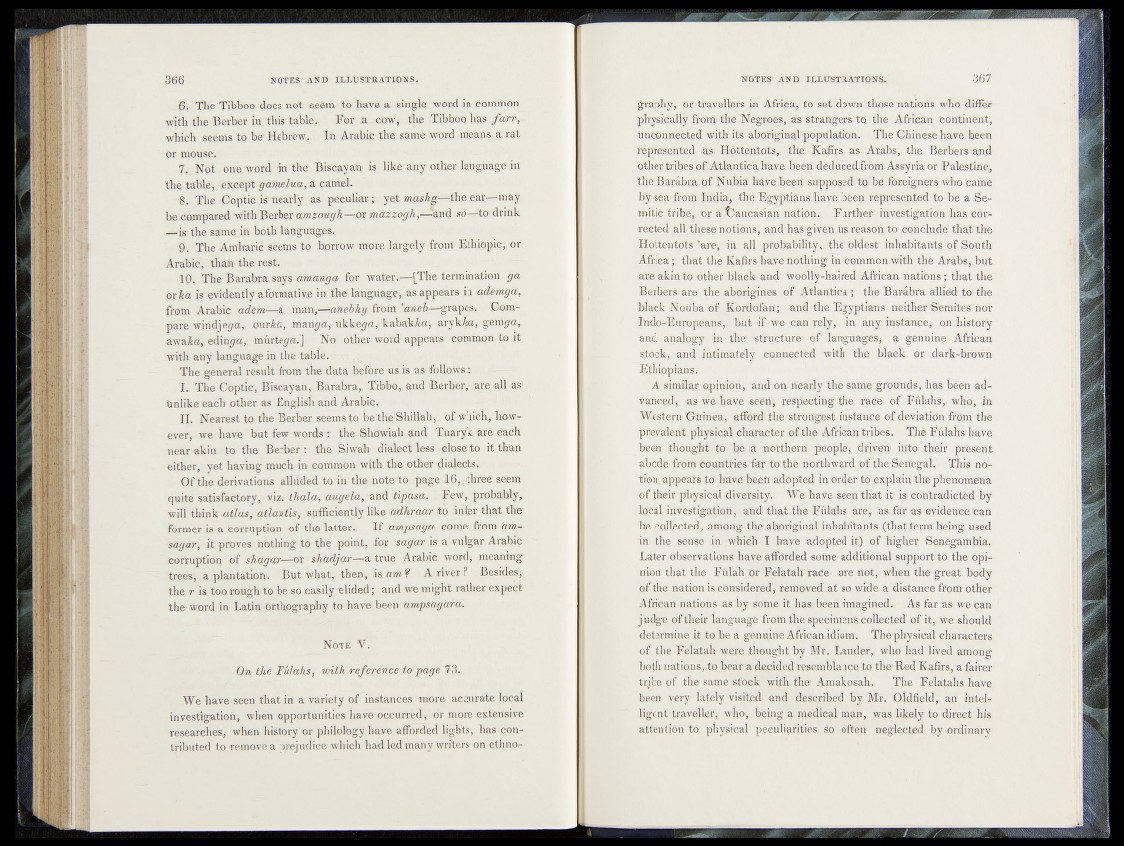
6. The Tibboo does not seem ,to;have-a single word in common
with the-Berber in this-table. ■ /For a-cow, ..the .Tibboo has fa rn T-
which seems to be Hebrew. In Arabic the same word means'a, rat
br mouse;.
7. Mot one word in the Biscayan is like any other language in
the table, except gamelua, a camel.
8. The Coptic is nearly as peculiar; yet mashg—the ear—may
be^compared with Berber amzwgh—
—is the same in both languages.
9. The Amharic seems to borrow more largely from Ethifipic, or
Arabic, than the rest.
TO. The Barabra says amanga for water.—'[The termination ga
prka is evidently aformative in the language, as appears in ademgd,
from Arabic adem—a man,—anebky from 'aneb—grapes. Compare
windjepa, our&a, manja, ukkepa, kabak&a, aryk&a, gempa,
awak, edinpa, mhrtejra.] § No other word appears common to it
’with any language-in the table.
Thehgeneral result from the data-before us is as, follows,:^
I. The Coptic, Biscayan, Barabra, Tibbo, and Berfer^ are all as"
Unlike each other as English and Arabic.
II. Nearest to the Berber seems to be the Shillali^df which, howl
ever, we have but few words: the Showiah and Tuaryk are each
near akin to the Berber: the Siwah dialect less-close to it than
either, yet having much in common with the other dialects.,
Of the derivations alluded to in the nbtc(totJp£tge"16, dhre,e>seem
quite satisfactory, viz. thala, augela, and tipasa. „ Few, probably,
will think atlas, atlantis, sufficiently like adhraar to .infer that the
former is a (corruption of the latter. If atnpsctga come from am-
sagar, if proves nothing to the point, for sagar is a vulgar Arabic
corruption of shagar—or shadjar-^& tTne Arabic word, meaning
trees, a plantation. But what, thenis am ? A river ? ' Besides,
the r is too rough to be so easily elided; and we might rather expect
the word in Latin orthography to have been ampsagara.
N ote V .
On the Fulahs, v)ith reference to page 73.
We haveseen that in a variety of instances more accurate local
investigation, when opportunities have occurred, or more extensive
researches, when history or philology have afforded lights, has contributed
to remove a prejudice which had led many writers on ethnography,
or-, treCyfellers in Africa, to set-idown those nations who differ
ph^^®Slfy fr^dtfi^tjhe-- NegroeSs as 'Strangers to the African continent,
unconnected with its aboriginal population. The Chinese have been
re^es'enied fas t the Kafirs as Arabs, the Berbers and
other tribes of Atlanticahav^roeemd'edtfoedfrom Assyria or Palestine,
the Barabra.of-Nubia have been,.supposed to be ibreigners who camte
by-sea- from' India, the Egypti&hs haye- ’been represented to be a Semite*
tribe, «©4aT)aucasi§jiaihedioh. S. Further, investigation has corrected5
.all thhs,e?potiqns» and has g&s&Rps reason to,'conclude that the
Hottentots 'are, in1 alk>prbb|#i,Irty, -the oldest‘ inhabitants of South
Africa; ■ that-;thepKafiislshajre nothtog in' common with the Arabs, but
are akin-to- other black afid^^oolly^haired African nations; that the
Berbers are; the »aborigines of Atladtioa.^ the Barabra allied to the
black .Nouba- of^Kordofan; and-:th1&:Egyptians ‘neither Semites; opr
Indo-Europe"ans,' but if we c a n f e l y a p y ' instance, on history
and analogy, in the sfruGtTor&fcof 'languages, a genuine African
stock, and tutimately connected with the black or. dark-brown
Ethiopians."' f
. A; similar opinion, and on nearly the same grounds, has been advanced,
as we have seen, respecting-the ‘race of Fulahs, <who, in
Wester-h Guinea, afford the strongest instance.of deviation from the
prevalent physical character of the African tribes. The Fdlahs havp
be©h; thought to be a northern people, driven into their prese*rit
abode from Countries far to the northward ofthe’Senegal." This Ratio
tL_appears to have been adopted in order to?explain the phenomena
of their physical diversity. We have seen that it is, contradicted by
local investigation, and that the Ffilahs are, as far as evidence can
be collected,-among the aboriginal inhabitants (that term being used
in the sense in which I have adopted it) .of higher Senegambia.
Later observations have afforded some additional support to the opinion
that the Ffilah or Felatah race are not, when the great body
qf the nation is considered, removed at so wide a distance from other
African nations as by some it has been imagined. As far as we can
judge of their language from the specimens collected of it, we should
determine it to be a genuine African idiom. The physical characters
of the Felatah were thought by Mr. Lander, • v ' • • • ' : .. : ;■ .f . ,s. who ■ h■ ' .a d lived'■ am•o neo*
both nations, to bear a decided resemblance to the Red Kafirs, a fairer
trjbe of the same stock with the Aroakosah. The Felatahs have
been very lately visited and described by Mr. Oldfield, an intelligent
traveller/ Vho, being g, medical man, was likely to direct his
attention to physical peculiarities so often neglected by ordinary